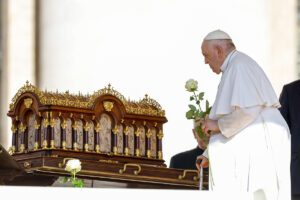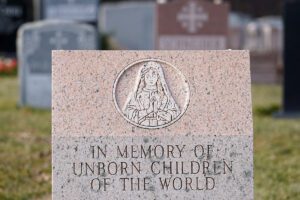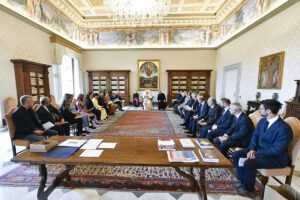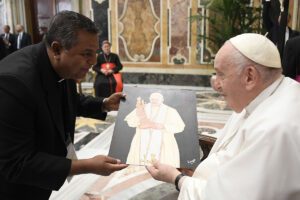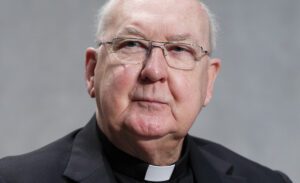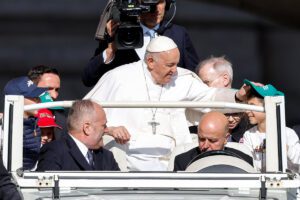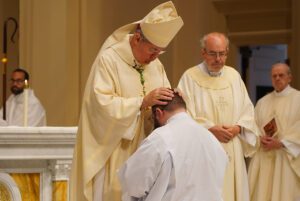ROME (CNS) – Pope Francis had a restful, peaceful first night at Rome’s Gemelli hospital after a successful three-hour operation June 7 for a hernia.
He has been informed of the many messages of “closeness and affection” from well-wishers and he “expresses his gratitude, while asking for continued prayers,” said Matteo Bruni, director of the Vatican press office, in a written statement June 8.
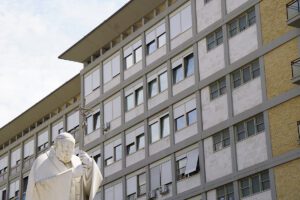
The medical staff in charge of monitoring the 86-year-old pope’s post-operative recovery said that “Pope Francis had a peaceful night, managing to rest extensively,” Bruni said.
The pope “is in good general condition, alert and breathing on his own. Routine follow-up examinations are good. He will observe the necessary post-operative rest for the entire day,” June 8, Bruni added.
The president of the U.S. Conference of Catholic Bishops, Archbishop Timothy P. Broglio of the U.S. Archdiocese for the Military Services, asked that Catholics “keep Pope Francis and all those in the hospital in your prayers.”
“As Pope Francis recovers from surgery, he is strengthened by faith in the healing power of our merciful God,” he said in a written statement released June 7. “Jesus always walks with us and is even closer whenever we need healing and comfort.”
Pope Francis underwent a three-hour abdominal surgery “without complications” June 7 to treat a hernia, according to the Vatican press office.
The 86-year-old pope was taken to Rome’s Gemelli hospital shortly after his general audience June 7. He was put under general anesthesia and underwent abdominal surgery to treat a hernia that developed at the site of abdominal incisions from previous operations, Dr. Sergio Alfieri, the chief surgeon operating on the pope, said at a news conference at the hospital following the operation.
Speaking to journalists after the surgery, Alfieri said Pope Francis had a number of internal scars and adhesions from two operations many years ago, possibly in Argentina; one was to treat peritonitis — inflammation of abdominal tissue — caused by an infected gallbladder and another to treat hydatid disease caused by cysts containing a parasite. It was this last operation that had left behind scars in the pope’s abdominal tissue where another hernia had developed.
Alfieri said that during the three-hour operation adhesions were found between the intestine and the membrane that lines the abdomen, that for months caused an “aggravating, painful” intestinal blockage.
The adhesions were freed during the surgery and the opening in the abdomen’s wall that led to the hernia was repaired with prosthetic mesh.
Alfieri, who also operated on the pope in 2021, said the pope had no complications and responded well to the general anesthesia he was administered during this surgery and the one in 2021 that removed part of his colon.
The chief surgeon underscored that, in both operations, all affected tissue had been benign.
“The pope does not have other illnesses,” he said.
Alfieri explained that while the medical team that follows the pope had been discussing the scheduled operation for several days, the final decision to operate was not taken until June 6, when Pope Francis briefly visited the hospital for a medical checkup and tests.
“It was not urgent,” he said, “or else we would have operated on him then.”
Before going to the hospital the pope seemed well and in good spirits, holding his general audience as usual, riding in the popemobile, blessing babies, walking with a cane and meeting special guests afterward. He had held two private meetings before the general audience in St. Peter’s Square.
Vatican News reported he arrived at the Gemelli hospital around 11:30 a.m. local time in the compact Fiat 500 he often rides in. The windows of the papal suite on the 10th floor of the hospital were opened just after 6 p.m.
Alfieri noted that shortly after the surgery Pope Francis was already working and making jokes, and had asked the surgeon in jest: “When are we doing the third (surgery)?”
While Alfieri said recovery for this operation typically lasts about seven days. Vatican News reported that the pope’s audiences have been canceled until June 18 as a “precaution.”
Bruni said June 7 that, for now, all events the pope was scheduled to attend after June 18 were still on his calendar and had not been canceled.
Pope Francis was scheduled to meet with 29 Nobel Peace Prize winners at the Vatican June 10 for an event to celebrate human fraternity. Before going to the hospital, the pope encouraged its organizers to continue with the event as planned without him, a statement from the foundation organizing the event said.
This was Pope Francis’ third hospitalization at the Gemelli hospital, the most recent was from March 29 to April 1 when he was admitted for an acute respiratory infection.

